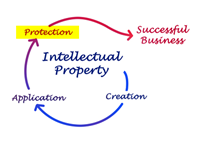According to IP Australia, two of the biggest Intellectual Property mistakes people make are:

The protection of valuable Intellectual Property is an important step to ensuring your business goals succeed.
- failing to keep your IP secret before applying for protection; and
- failing to secure ownership of the IP before bringing it into the public domain.
If you are considering licensing your intellectual property as a means of bringing it to the market, then you need to think about and act on these key issues.
Entering into confidentiality agreements when negotiating with potential partners or licensees
It is essential that you maintain confidentiality agreements with all parties involved in the commercialisation process.
You will need to ensure that confidentiality is maintained throughout the negotiation stage with any potential licensees or investors, as well as during the term of any licence period with the licensee.
You should ensure that all parties involved sign a confidentiality and non-disclosure agreement, to ensure sensitive information is treated in a confidential manner, and not used for purposes other than those you nominate.
Licensing IP
Under an IP licence, the owner of the IP allows another person to use it, in accordance with agreed terms and conditions. In return, the licensee will pay a licence fee, royalties or other amount as agreed.
A licence can stipulate:-
- a defined territory;
- a set market, industry, field, or purpose that the IP may be used in;
- a class of products which the IP may be used in connection with;
- a certain term or length of time the license may operate; and
- contain other terms and conditions relating to use of the IP, product development, manufacture, marketing and distribution of products or services.
In the license agreement, the owner of the IP may give up certain rights. These may include the right to commercially exploit the IP either exclusively or within a certain territory.
However, the IP owner will retain ownership rights to the IP.
Licencing is an attractive option to commercialise IP, where the IP owner does not have the expertise or means to do so himself.
Not to be confused with assigning
Assigning your IP is not the same as licencing.
If someone assigns intellectual property, it means they are transferring the ownership of the intellectual property to another person – that is, they are selling it.
This is in contrast to licencing, which grants another person the right to use the intellectual property, on certain terms and conditions, with the ownership of the IP staying with the IP owner.
Types of intellectual property
The types of intellectual property that can be licenced include:- 
- trademarks;
- copyright;
- patents;
- designs;
- software;
- business processes;
- systems and;
- technology.
Other options to commercialise your intellectual property
Other options to consider when commercialising your valuable intellectual property include in-house commercialisation (where you have the necessary resources and know-how to bring your IP to market in-house), a joint venture, partnership, start up company with suitable investors, or an established company.
Overseas protection of IP
Note that the registration systems in Australia only afford protection within Australia.
You may need to register your IP in appropriate overseas jurisdictions, if you are planning on exporting products and/or services, or otherwise using your IP overseas.
See here for more information on overseas protection.
Protect your intellectual property
Ensure your intellectual property is registered and adequately secure, before you use it.
By ensuring all appropriate measures are in place to protect your rights, you will help prevent the misuse of your IP and gain maximum protection. This will assist you in enforcing your rights against misuse if need be at a later date.
You might also be interested in
Australian government business portal

